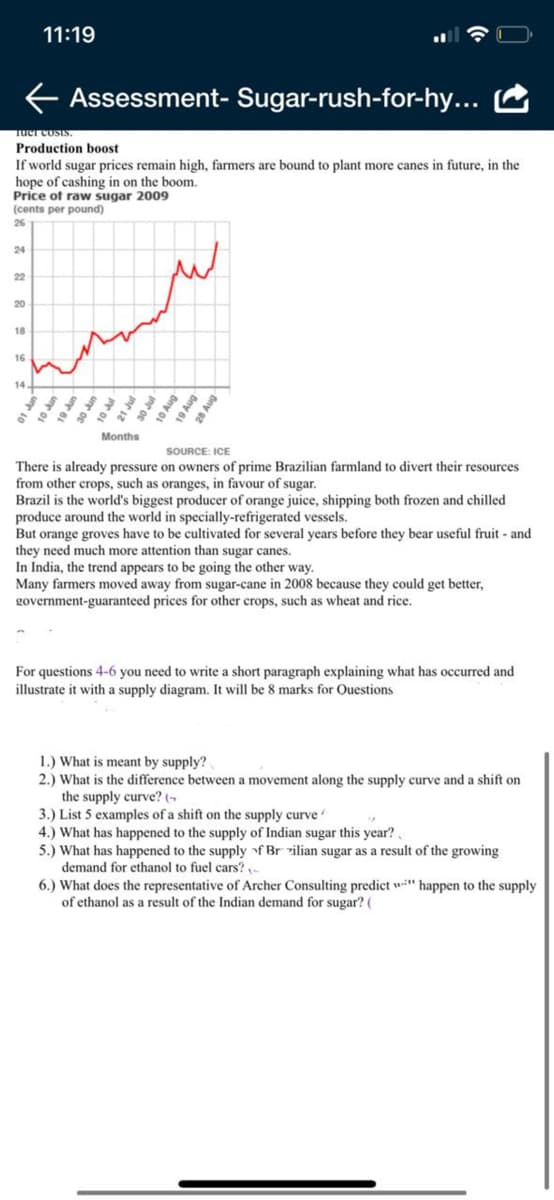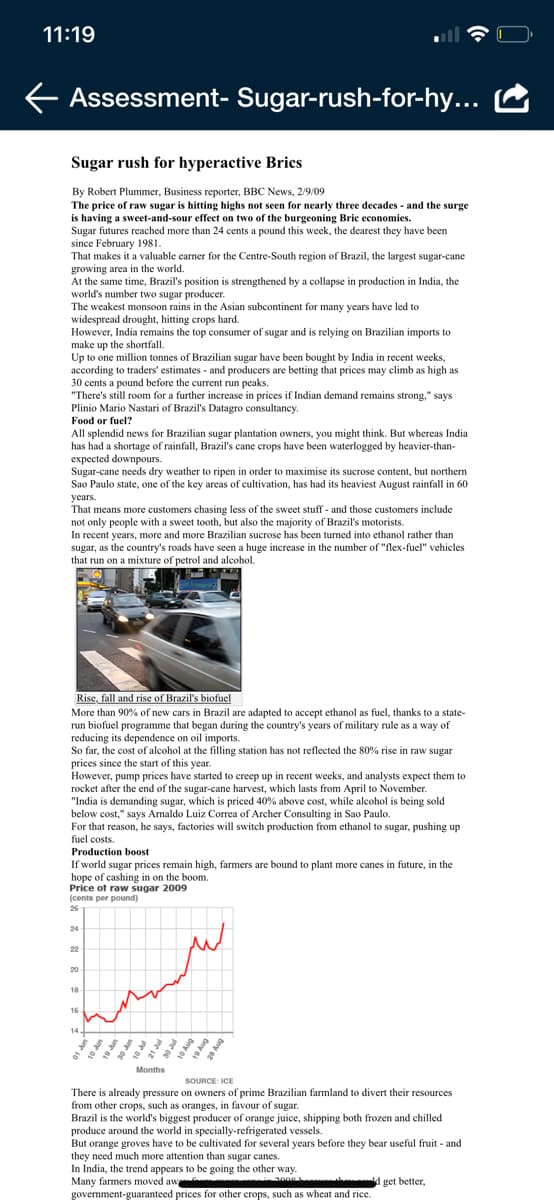1.) What is meant by supply? 2.) What is the difference between a movement along the supply curve and a shift on the supply curve? (- 3.) List 5 examples of a shift on the supply curve 4.) What has happened to the supply of Indian sugar this year? 5.) What has happened to the supply of Br rilian sugar as a result of the growing demand for ethanol to fuel cars? 6.) What does the representative of Archer Consulting predict " happen to the supply of ethanol as a result of the Indian demand for sugar? (
1.) What is meant by supply? 2.) What is the difference between a movement along the supply curve and a shift on the supply curve? (- 3.) List 5 examples of a shift on the supply curve 4.) What has happened to the supply of Indian sugar this year? 5.) What has happened to the supply of Br rilian sugar as a result of the growing demand for ethanol to fuel cars? 6.) What does the representative of Archer Consulting predict " happen to the supply of ethanol as a result of the Indian demand for sugar? (
Principles of Economics 2e
2nd Edition
ISBN:9781947172364
Author:Steven A. Greenlaw; David Shapiro
Publisher:Steven A. Greenlaw; David Shapiro
Chapter33: International Trade
Section: Chapter Questions
Problem 6SCQ: Table 33.15 shows how the average costs of production for semiconductors (the chips In computer...
Related questions
Question

Transcribed Image Text:11:19
Assessment- Sugar-rush-for-hy...
Tuer costs.
Production b0ost
If world sugar prices remain high, farmers are bound to plant more canes in future, in the
hope of cashing in on the boom.
Price of raw sugar 2009
(cents per pound)
26
24
22
20
18
16
14
10 un
Months
SOURCE: ICE
There is already pressure on owners of prime Brazilian farmland to divert their resources
from other crops, such as oranges, in favour of sugar.
Brazil is the world's biggest producer of orange juice, shipping both frozen and chilled
produce around the world in specially-refrigerated vessels.
But orange groves have to be cultivated for several years before they bear useful fruit - and
they need much more attention than sugar canes.
In India, the trend appears to be going the other way.
Many farmers moved away from sugar-cane in 2008 because they could get better,
government-guaranteed prices for other crops, such as wheat and rice.
For questions 4-6 you need to write a short paragraph explaining what has occurred and
illustrate it with a supply diagram. It will be 8 marks for Ouestions
1.) What is meant by supply?
2.) What is the difference between a movement along the supply curve and a shift on
the supply curve? (-
3.) List 5 examples of a shift on the supply curve
4.) What has happened to the supply of Indian sugar this year?.
5.) What has happened to the supply f Brrilian sugar as a result of the growing
demand for ethanol to fuel cars? -
6.) What does the representative of Archer Consulting predict w" happen to the supply
of ethanol as a result of the Indian demand for sugar? (
21 Jul
30 Jul
10 Aug
19 Aug
28 Aug

Transcribed Image Text:11:19
Assessment- Sugar-rush-for-hy...
Sugar rush for hyperactive Brics
By Robert Plummer, Business reporter, BBC News, 2/9/09
The price of raw sugar is hitting highs not seen for nearly three decades - and the surge
is having a sweet-and-sour effecet on two of the burgeoning Brie economies.
Sugar futures reached more than 24 cents a pound this week, the dearest they have been
since February 1981.
That makes it a valuable earmer for the Centre-South region of Brazil, the largest sugar-cane
growing area in the world.
At the same time, Brazil's position is strengthened by a collapse in production in India, the
world's number two sugar producer.
The weakest monsoon rains in the Asian subcontinent for many years have led to
widespread drought, hitting crops hard.
However, India remains the top consumer of sugar and is relying on Brazilian imports to
make up the shortfall.
Up to one million tonnes of Brazilian sugar have been bought by India in recent weeks,
according to traders' estimates - and producers are betting that prices may climb as high as
30 cents a pound before the current run peaks.
"There's still room for a further increase in prices if Indian demand remains strong," says
Plinio Mario Nastari of Brazil's Datagro consultancy.
Food or fuel?
All splendid news for Brazilian sugar plantation owners, you might think. But whereas India
has had a shortage of rainfall, Brazil's cane crops have been waterlogged by heavier-than-
expected downpours.
Sugar-cane needs dry weather to ripen in order to maximise its sucrose content, but northern
Sao Paulo state, one of the key areas of cultivation, has had its heaviest August rainfall in
усаrs.
That means more customers chasing less of the sweet stuff - and those customers include
not only people with a sweet tooth, but also the majority of Brazil's motorists.
In recent years, more and more Brazilian sucrose has been turned into ethanol rather than
sugar, as the country's roads have seen a huge increase in the number of "flex-fuel" vehicles
that run on a mixture of petrol and alcohol.
Rise, fall and rise of Brazil's biofuel
More than 90% of new cars in Brazil are adapted to accept ethanol as fuel, thanks to a state-
run biofuel programme that began during the country's years of military rule as a way of
reducing its dependence on oil imports.
So far, the cost of alcohol at the filling station has not reflected the 80% rise in raw sugar
prices since the start of this year.
However, pump prices have started to creep up in recent weeks, and analysts expect them to
rocket after the end of the sugar-cane harvest, which lasts from April to November.
"India is demanding sugar, which is priced 40% above cost, while alcohol is being sold
below cost," says Amaldo Luiz Correa of Archer Consulting in Sao Paulo.
For that reason, he says, factories will switch production from ethanol to sugar, pushing up
fuel costs.
Production boost
If world sugar prices remain high, farmers are bound to plant more canes in future, in the
hope of cashing in on the boom.
Price ot raw sugar 2009
(cents per pound)
26
24
22
20
18
16
14.
Months
SOURCE: ICE
There is already pressure on owners of prime Brazilian farmland to divert their resources
from other crops, such as oranges, in favour of sugar.
Brazil is the world's biggest producer of orange juice, shipping both frozen and chilled
produce around the world in specially-refrigerated vessels.
But orange groves have to be cultivated for several years before they bear useful fruit - and
they need much more attention than sugar canes.
In India, the trend appears to be going the other way.
Many farmers moved aw
government-guaranteed prices for other crops, such as wheat and rice.
i 000 d get better,
10 Aug
19 Aug
28 Aug
Expert Solution
This question has been solved!
Explore an expertly crafted, step-by-step solution for a thorough understanding of key concepts.
This is a popular solution!
Trending now
This is a popular solution!
Step by step
Solved in 2 steps

Knowledge Booster
Learn more about
Need a deep-dive on the concept behind this application? Look no further. Learn more about this topic, economics and related others by exploring similar questions and additional content below.Recommended textbooks for you

Principles of Economics 2e
Economics
ISBN:
9781947172364
Author:
Steven A. Greenlaw; David Shapiro
Publisher:
OpenStax

Principles of Microeconomics
Economics
ISBN:
9781305156050
Author:
N. Gregory Mankiw
Publisher:
Cengage Learning


Principles of Economics 2e
Economics
ISBN:
9781947172364
Author:
Steven A. Greenlaw; David Shapiro
Publisher:
OpenStax

Principles of Microeconomics
Economics
ISBN:
9781305156050
Author:
N. Gregory Mankiw
Publisher:
Cengage Learning


Essentials of Economics (MindTap Course List)
Economics
ISBN:
9781337091992
Author:
N. Gregory Mankiw
Publisher:
Cengage Learning

Brief Principles of Macroeconomics (MindTap Cours…
Economics
ISBN:
9781337091985
Author:
N. Gregory Mankiw
Publisher:
Cengage Learning